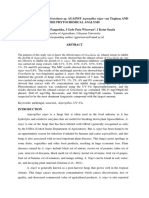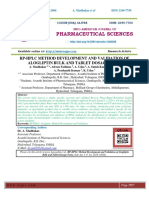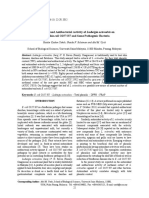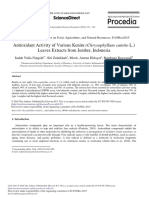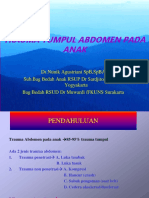A B S T R A C T: Amboinicus' (Cubanoregano) Crude Trichophyton Mentagrophytes
A B S T R A C T: Amboinicus' (Cubanoregano) Crude Trichophyton Mentagrophytes
Uploaded by
STEM 8 PRODUCTIONSCopyright:
Available Formats
A B S T R A C T: Amboinicus' (Cubanoregano) Crude Trichophyton Mentagrophytes
A B S T R A C T: Amboinicus' (Cubanoregano) Crude Trichophyton Mentagrophytes
Uploaded by
STEM 8 PRODUCTIONSOriginal Title
Copyright
Available Formats
Share this document
Did you find this document useful?
Is this content inappropriate?
Copyright:
Available Formats
A B S T R A C T: Amboinicus' (Cubanoregano) Crude Trichophyton Mentagrophytes
A B S T R A C T: Amboinicus' (Cubanoregano) Crude Trichophyton Mentagrophytes
Uploaded by
STEM 8 PRODUCTIONSCopyright:
Available Formats
ANGELES, LATUPAN, MITRA, SANTOS, SOTTO, VALENZUELA
PHYTOCHEMICAL SCREENING AND
ANTIFUNGAL ACTIVITY OF PLECTRANTHUS
AMBOINICUS’ (CUBANOREGANO) CRUDE
ETHANOLIC EXTRACT AGAINST
TRICHOPHYTON MENTAGROPHYTES
A B S T R A C T
Plants with medicinal properties have been applied for a long period of time in the traditional healthcare system. The proponents of this study aimed to
contribute to the advancement of agriculture and healthcare systems through developing home-grown remedies in common skin diseases. The study was carried
out with an objective to investigate the antifungal potentials of Plectranthus amboinicus (Cuban Oregano) leaves and the positive phytochemicals that are
probable contributors for the antifungal property. The aim of the study is to assess the antifungal activity, to determine the zone of inhibition of the crude
ethanolic extract per diluted concentrations, and determine the significant differences per ratio of concentration. Before conducting the experiments, the leaves
of the oregano went through preliminary analysis, where a sample of the Cuban oregano leaf was set into the screening material to determine its authenticity.
After the preliminary analysis, 1.5 kilograms of oregano leaves were crushed, chopped and dried, leaving a yield of 664.23 grams of chopped and dried leaves. The
leaves of Cuban Oregano were extracted through maceration, Soxhlet extraction and Rotary evaporation with a 95% grade ethanol as its solvent. After the
extraction, a crude ethanolic extract with an 81.331 g/mL was procured. The researchers took a 50 g/mL sample from the extract to be used in the proceeding
methods of phytochemical screening. The crude ethanolic extract of the Cuban Oregano went through Phytochemical screening to determine the phytochemical
constituents present in its leaves. The results of the screening revealed that the extract was positive in Flavonoids, Saponins, and Phytosterols. The qualitative
analysis for the positive phytochemicals was further used to support the hypothetical claim regarding the antifungal activity of the extract. Along the process of
phytochemical screening, the preparation for fungal culture was held. The researchers followed preliminary sterilization procedures before proceeding into the
culturation. The researchers used a solid culture media, where in the Trichophyton mentagrophytes sample was inoculated into a petri dish with an Agar-Agar
medium (Mueller-Hinton Agar) and was incubated for about 7 days. After the fungi has grown, it was dispensed into culture tubes and was sealed and brought into
preparation for the antifungal assay. After the phytochemical screening, the remaining extract of 30.331 g/mL and was divided into three portions resulting into
10.444 g/mL per sample and was further diluted into three ratios of concentrations (100% pure crude ethanolic extract, 75% - crude ethanolic extract with 25% 95%
grade ethanol, and 50% crude ethanolic extract and 50% 95% grade ethanol). Each of the concentrations was investigated for antifungal activity against
Trichophyton mentagrophytes through Kirby-Bauer's disk diffusion assay method and assessed its zone of inhibition. Results revealed that the 100%
concentration or the pure crude ethanolic extract showed greater zones of inhibition in all three trials with an 8 to 10 mm range per disk producing a p-value of
0.85027 which is greater than the standard p-value 0.05. Moreover, the 100% pure crude ethanolic extract showed constant results all throughout the experiment
compared to the 75% concentration and the 25% concentration which showed no effect or no inhibition.
Results and Discussion
M MACERATION
E The result of the One-Way Anova showed that the p-value of the 100% concentration
is 0.85027, meaning there are no significant differences between trials. This is
T
greater than p-value 0.05, meaning that it is not an effective agent against
Extraction using Soxhlet Apparatus and
Trichophyton mentagrophytes. The 100% concentration of the oregano extract
Rotary Evaporator showed that it has a constant effect on the zone of inhibition. The average of the
H effect ranges from 8 to 10mm. On the other hand, using 50% and 75% concentration
of the extract did not produce any effect on the fungal infestation and produced 0
O PHYTOCHEMICAL value of zone of inhibition, hence, did not reduce the size of the fungi.
D SCREENING
CONCLUSION
O The researchers ought to conclude that there are no significant differences between the three
concentrations of the oregano extract. The results were based on the One-Way ANOVA, which showed
L DILUTION a p-value of 0.85027 which is higher than that of 0.05. Thus, the researchers accept the null hypothesis.
Although there are no significant differences, the 100% concentration have a constant effect on the
O zone of inhibition. It has an average effect of 8 to 10mm, which is relatively higher than the standard
6mm. Thereby stating that the concentration is an effective antifungal agent. The two other
G ANTIFUNGAL
concentrations, 50% and 75%, have no effect on the inhibition at all.
Y
Khan, D. M., Kl, S., Bernaitis, L., & Shenoy, R. P. (2013, January). International Journal of Biological & Pharmaceutical Research ANTIFUNGAL ACTIVITYOF TAXUS
BACCATA, PHYLLANTHUS DEBILIS, PLECTRANTHUS AMBOINICUS AGAINST CANDIDA SPECIES OF CLINICAL ORIGIN. Retrieved from
https://www.researchgate.net/publication/291274081_International_Journal_of_Biological_Pharmaceutical_Research_ANTIFUNGAL_ACTIVITYOF_TAXUS_BACCATA
_PHYLLANTHUS_DEBILIS_PLECTRANTHUS_AMBOINICUS_AGAINST_CANDIDA_SPECIES_OF_CLINICAL_ORIGIN?fbclid=IwAR0Y8ERTRw0x6i8RA3pD8
fBVSMva4AV6dMeLS9FyTeN9xPXqFUWj-EtQ2w
Manjamalai, A., Narala, Y., Haridas, A., & Berlin Grace, V. M. (2011, January 28). Antifungal, Anti¬inflammatory And Gc – Ms Analysis Of Methanolic Extract Of
Plectranthus Amboinicus Leaf. Retrieved from
https://innovareacademics.in/journal/ijcpr/Issues/Vol3Issue2/330.pdf?fbclid=IwAR0B 9k4XOXXBiYEw8xW8YVYdgAGKGDnH5hz6TRZpWyP2Nq6b7IUr0YwOIw
You might also like
- Indian - MDR 2017 - Form ListDocument3 pagesIndian - MDR 2017 - Form ListRegulatory QualityNo ratings yet
- Determination of Total Anthocyanin & Evaluation of Its Chemical PropertiesDocument20 pagesDetermination of Total Anthocyanin & Evaluation of Its Chemical PropertiesClarisshaNo ratings yet
- Experimental approaches to Biopharmaceutics and PharmacokineticsFrom EverandExperimental approaches to Biopharmaceutics and PharmacokineticsNo ratings yet
- The Effect of Different Concentrations of Bay Leaves (Syzygium Polyanthum)Document4 pagesThe Effect of Different Concentrations of Bay Leaves (Syzygium Polyanthum)yuuu_chanNo ratings yet
- Method Development and Validation of Afatinib in Bulk and Pharmaceutical Dosage Form by Uvspectroscopic MethodDocument7 pagesMethod Development and Validation of Afatinib in Bulk and Pharmaceutical Dosage Form by Uvspectroscopic MethodBaru Chandrasekhar RaoNo ratings yet
- Comparative Study of RP-HPLC and UV Spectrophotometric Techniques For The Simultaneous Determination of Amoxicillin and Cloxacillin in CapsulesDocument6 pagesComparative Study of RP-HPLC and UV Spectrophotometric Techniques For The Simultaneous Determination of Amoxicillin and Cloxacillin in Capsulesiabureid7460No ratings yet
- Evaluation of Antioxidant Activity of Clove Syzygium AromaticumDocument8 pagesEvaluation of Antioxidant Activity of Clove Syzygium AromaticumTrina ViskhawatNo ratings yet
- Aspergillus Niger JournalDocument9 pagesAspergillus Niger JournalNevy Widya PangestikaNo ratings yet
- Aspergillus Niger JournalDocument9 pagesAspergillus Niger JournalNevy Widya PangestikaNo ratings yet
- Spectrophotometric Method For Polyphenols Analysis Pre Validation and Application On Plantago L SpeciesDocument6 pagesSpectrophotometric Method For Polyphenols Analysis Pre Validation and Application On Plantago L SpeciesVan CarlosNo ratings yet
- RP-HPLC Method Development and Validation of Alogliptin Bulk and Tablet Dosage FormDocument8 pagesRP-HPLC Method Development and Validation of Alogliptin Bulk and Tablet Dosage FormBaru Chandrasekhar RaoNo ratings yet
- In Vitro Antioxidant Activities of Chloroform Extract of Crossandra Infundibuliformis.Document4 pagesIn Vitro Antioxidant Activities of Chloroform Extract of Crossandra Infundibuliformis.iajpsNo ratings yet
- Biological Monitoring of Exposure To SolventsDocument12 pagesBiological Monitoring of Exposure To SolventsRicardo SoldadoNo ratings yet
- Drug-Drug Interaction Studies of Levocetirizine With AtenololDocument7 pagesDrug-Drug Interaction Studies of Levocetirizine With AtenololSabrina JonesNo ratings yet
- Formulation, Evaluation and Optimization of Floating Matrix Tablets of CarvedilolDocument15 pagesFormulation, Evaluation and Optimization of Floating Matrix Tablets of CarvedilolBaru Chandrasekhar RaoNo ratings yet
- Antibacterial Activity of SAMBONG (Blumea Balsamifera) Ethanol Leaf Extract AGAINST Enterococcus FaecalisDocument14 pagesAntibacterial Activity of SAMBONG (Blumea Balsamifera) Ethanol Leaf Extract AGAINST Enterococcus FaecalisAlyssa Leah EvangelistaNo ratings yet
- 7.) Review of Related LiteratureDocument7 pages7.) Review of Related LiteratureJayson BanalNo ratings yet
- Antitumural Effect Uncaria TomentosaDocument6 pagesAntitumural Effect Uncaria TomentosaDiego Chicaíza FinleyNo ratings yet
- Molecules 18 06852 v2Document13 pagesMolecules 18 06852 v2Emmanuel BonninNo ratings yet
- Sambiiloto Dann Hiv PDFDocument6 pagesSambiiloto Dann Hiv PDFUeki Cinta LingkunganNo ratings yet
- Experimental Treatment of Recurrent Otitis Externa: Open Veterinary Journal, (2015), Vol. 5 (1) : 38-41Document4 pagesExperimental Treatment of Recurrent Otitis Externa: Open Veterinary Journal, (2015), Vol. 5 (1) : 38-41Christian ThamNo ratings yet
- Antimicrob. Agents Chemother. 1998 Klepser 1207 12Document7 pagesAntimicrob. Agents Chemother. 1998 Klepser 1207 12Hajrah SuhardiNo ratings yet
- Neem Diffrent ConcentrationDocument3 pagesNeem Diffrent ConcentrationTahir AliNo ratings yet
- Antioxidant and Antibacterial Activity of Ludwigia Octovalvis OnDocument8 pagesAntioxidant and Antibacterial Activity of Ludwigia Octovalvis Onnguyen ba trungNo ratings yet
- J Jtumed 2016 11 006Document4 pagesJ Jtumed 2016 11 006yulyansyah susantoNo ratings yet
- Crawling Assay ProposalDocument11 pagesCrawling Assay ProposalArabelle SantosNo ratings yet
- Kouadri 2018Document8 pagesKouadri 2018Miyyada AichaouiNo ratings yet
- Research ArticleDocument8 pagesResearch ArticleBasile Saka Boni KONMYNo ratings yet
- erickson1995Document10 pageserickson1995thabitabastosNo ratings yet
- 2015 Phytomedicine SinergisticDocument13 pages2015 Phytomedicine SinergisticGaviota7310No ratings yet
- Ayad Et Al - Antibacterial.efficiency - PomeloDocument5 pagesAyad Et Al - Antibacterial.efficiency - PomeloJesus NavaNo ratings yet
- Study of DissolutionDocument4 pagesStudy of DissolutionDaniiel Miranda ZevallosNo ratings yet
- Treatment of Superfacial Mycoses Research-Ebercanozole /ebernetDocument10 pagesTreatment of Superfacial Mycoses Research-Ebercanozole /ebernetHajrah MirandaNo ratings yet
- Rapid STRDocument39 pagesRapid STRNicole Ava ChangNo ratings yet
- Absence of Mutagenicity in Three Nigerian Medicinal Plants - Bidens Pilosa, Cleistopholis Paterns andDocument7 pagesAbsence of Mutagenicity in Three Nigerian Medicinal Plants - Bidens Pilosa, Cleistopholis Paterns andAlvaro MarceloNo ratings yet
- Indian Mango Research Grand FinalDocument11 pagesIndian Mango Research Grand FinalJoyce Vanessa NavajaNo ratings yet
- Efek Sitotoksik Tetrahydrozoline HCL Terhadap Viabilitas Sel Fibroblast Tri Purnami DewiDocument80 pagesEfek Sitotoksik Tetrahydrozoline HCL Terhadap Viabilitas Sel Fibroblast Tri Purnami DewiKara AraujoNo ratings yet
- Apjcp 19 2911Document6 pagesApjcp 19 2911Arian RahimiNo ratings yet
- Insecticidal Activity of Panyawan Tinosp PDFDocument30 pagesInsecticidal Activity of Panyawan Tinosp PDFWarren Dela CernaNo ratings yet
- 2023 55 Correlations between antioxidantDocument11 pages2023 55 Correlations between antioxidantrodriguemchelNo ratings yet
- Simultaneous Determination of Ethinylestradiol and Levonorgestrel in Oral Contraceptives by Derivate SpectrophotometryDocument4 pagesSimultaneous Determination of Ethinylestradiol and Levonorgestrel in Oral Contraceptives by Derivate SpectrophotometryRoger ManzanarezNo ratings yet
- 2.format - Eng-Evaluation of Novaluron 5.25 % + Emamectin Benzoate 0.9% SC Against Chilli Fruit BorersDocument8 pages2.format - Eng-Evaluation of Novaluron 5.25 % + Emamectin Benzoate 0.9% SC Against Chilli Fruit BorersImpact JournalsNo ratings yet
- Evaluation of Effectiveness of Moringa'S Leaves Against EscherichiaDocument6 pagesEvaluation of Effectiveness of Moringa'S Leaves Against EscherichiagugugagagiaNo ratings yet
- toxicidad correhuelaDocument4 pagestoxicidad correhuelaTanathos GrimNo ratings yet
- Qiu 2014Document6 pagesQiu 2014kevin gelaudeNo ratings yet
- Tugas Buat JurnalDocument7 pagesTugas Buat JurnalSiskaApriliaNo ratings yet
- 1 s2.0 S2307410823000524 MainDocument4 pages1 s2.0 S2307410823000524 MainTanti 01No ratings yet
- Antibacterial Effect of Radish Tubers (Raphanus Sativus L.) OnDocument10 pagesAntibacterial Effect of Radish Tubers (Raphanus Sativus L.) OnTJPRC PublicationsNo ratings yet
- Guru Nanak Institute of Pharmacy, Ibrahimpatnam, Hyderabad-501506, Dist-Ranga Reddy, Andhra PradeshDocument9 pagesGuru Nanak Institute of Pharmacy, Ibrahimpatnam, Hyderabad-501506, Dist-Ranga Reddy, Andhra PradeshNur Aini IktikhafsariNo ratings yet
- Klebsiella Pneumoniae METODE DILUSIDocument6 pagesKlebsiella Pneumoniae METODE DILUSIpungky pradanaNo ratings yet
- For Pre-Final DefenseDocument12 pagesFor Pre-Final DefenseYlizia AuburnNo ratings yet
- 4534-Article Text-13134-1-10-20141126Document12 pages4534-Article Text-13134-1-10-20141126Jester DalanNo ratings yet
- The Skin Prick Test - European Standards: Clinical and Translational Allergy February 2013Document11 pagesThe Skin Prick Test - European Standards: Clinical and Translational Allergy February 2013niyatihopesNo ratings yet
- Should Solubility and Zone of Inhibition Be The OnlyDocument7 pagesShould Solubility and Zone of Inhibition Be The OnlyDian Fitri ChairunnisaNo ratings yet
- Antioxidant Activity of Various Kenitu (Chrysophyllum Cainito L.) Leaves Extracts From Jember, IndonesiaDocument8 pagesAntioxidant Activity of Various Kenitu (Chrysophyllum Cainito L.) Leaves Extracts From Jember, IndonesiasriyuliyansahNo ratings yet
- Saturation Reduces in Vitro Leakage of Monomers From Com 2018 Dental MateriaDocument8 pagesSaturation Reduces in Vitro Leakage of Monomers From Com 2018 Dental MateriaJullien FreitasNo ratings yet
- Anti Inflammation 3Document4 pagesAnti Inflammation 3zakaria boualNo ratings yet
- Antileishmanial, Antioxidant, and Cytotoxic Activities of Quercus Infectoria Olivier ExtractDocument8 pagesAntileishmanial, Antioxidant, and Cytotoxic Activities of Quercus Infectoria Olivier ExtractAndrea Rojas SeminarioNo ratings yet
- Chemistry Prject ReportDocument35 pagesChemistry Prject ReportAJ ONLINENo ratings yet
- Glutathione Peroxidase Activity Assay With Colorimetric Method and Microplate Reading Format and Comparison With Chemiluminescence MethodDocument7 pagesGlutathione Peroxidase Activity Assay With Colorimetric Method and Microplate Reading Format and Comparison With Chemiluminescence MethodAudrey LyliNo ratings yet
- Anti-Inflammatory, Antioxidant and Antifungal Activity Of: Chuquiraga SpinosaDocument7 pagesAnti-Inflammatory, Antioxidant and Antifungal Activity Of: Chuquiraga Spinosadome torresNo ratings yet
- TN3 Unit 1 2assessmentDocument4 pagesTN3 Unit 1 2assessmentAlvaro Scorza0% (1)
- @what Parents Should Know About Flatfeet, Intoeing, Bent Legs and Shoes For Children (Poster)Document1 page@what Parents Should Know About Flatfeet, Intoeing, Bent Legs and Shoes For Children (Poster)АлексNo ratings yet
- Dentin Jurnal Kedokteran Gigi Vol V. No 2. Agustus 2021 Gambaran Radiografi Panoramik Paska Odontektomi Kondisi AbnormalDocument6 pagesDentin Jurnal Kedokteran Gigi Vol V. No 2. Agustus 2021 Gambaran Radiografi Panoramik Paska Odontektomi Kondisi AbnormalRut ViodettaNo ratings yet
- Drugless Therapies Foundation Brochure 1Document1 pageDrugless Therapies Foundation Brochure 1gallery.art.coNo ratings yet
- FDA Drug Shortages Ketorolac InjectionDocument7 pagesFDA Drug Shortages Ketorolac InjectionAmruta JethwaNo ratings yet
- Learning InglesDocument14 pagesLearning InglesCarolina RojasNo ratings yet
- Conduct Hearing of Dr. Morgan OsborneDocument10 pagesConduct Hearing of Dr. Morgan OsborneCTV CalgaryNo ratings yet
- Pandas-Series &DF-Term1-24-25Document12 pagesPandas-Series &DF-Term1-24-25iisr student is hereNo ratings yet
- Doctor Freud Not Edited SongsDocument4 pagesDoctor Freud Not Edited SongsFrederick PasquinNo ratings yet
- Brosur Mobile Xray TRIUP TRF100 HORIZONDocument2 pagesBrosur Mobile Xray TRIUP TRF100 HORIZONdrestadyumna Chilspider0% (1)
- Exercise For Asking and Giving AdviceDocument1 pageExercise For Asking and Giving AdviceTiara WulandariNo ratings yet
- Blunt Adominal TraumaDocument14 pagesBlunt Adominal TraumaMuhammad Bima AkbarNo ratings yet
- Direct Observation of Procedural SkillsDocument5 pagesDirect Observation of Procedural SkillsDr.Fouzia KirmaniNo ratings yet
- Timesheet - Live-In - Amazing CaregiversDocument1 pageTimesheet - Live-In - Amazing Caregiverslokiyik598No ratings yet
- Dermatologists AustraliaDocument176 pagesDermatologists AustraliaSubashNo ratings yet
- Risk For Falls NCPDocument1 pageRisk For Falls NCPandayaannedhesireeNo ratings yet
- Daftar Obat High AlertDocument2 pagesDaftar Obat High AlertIgd Pondok TjandraNo ratings yet
- Oral Medicine & RadiologyDocument28 pagesOral Medicine & RadiologyDr.N.Shainu BabuNo ratings yet
- Making A Medical Appointment Conversation Topics Dialogs 72661Document4 pagesMaking A Medical Appointment Conversation Topics Dialogs 72661Pablo BandeiraNo ratings yet
- Module 3 CaregivingDocument10 pagesModule 3 CaregivingRioja Anna MilcaNo ratings yet
- Chest Tube ThoracostomyDocument1 pageChest Tube ThoracostomyYESSAMIN GUADIZNo ratings yet
- Syok Hipo 2Document10 pagesSyok Hipo 2amandamelaNo ratings yet
- Trauma Vascular Perifer: What We Should Do?Document56 pagesTrauma Vascular Perifer: What We Should Do?Nisrina AfifahNo ratings yet
- GROUP 4 Hospital Forms PDFDocument3 pagesGROUP 4 Hospital Forms PDFCASPERNo ratings yet
- Lerone 1997Document4 pagesLerone 1997Narjes Sharif AskariNo ratings yet
- Benda Asing Pada Hidung, TelingaDocument13 pagesBenda Asing Pada Hidung, TelingaAdel100% (1)
- Jadwal Poli Rsu at Medika-3Document2 pagesJadwal Poli Rsu at Medika-3Yohanis TarukNo ratings yet
- Calhoun ProceduresDocument247 pagesCalhoun ProceduresINDIA SPECIAL PROPERTYNo ratings yet
- Chapter 2 - Power System in HospitalDocument39 pagesChapter 2 - Power System in Hospitalmarye agegnNo ratings yet








